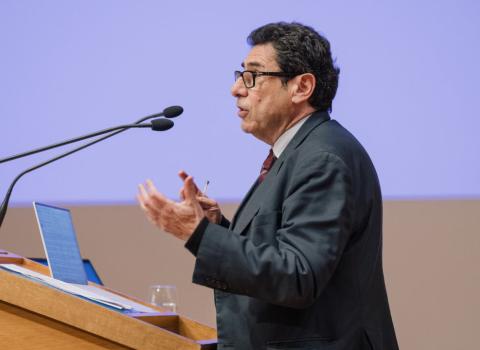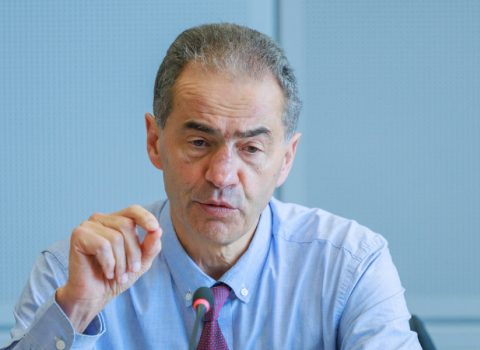Keith Pavitt was a professor at the Science Policy Research Unit at Sussex University, one of the most influential think-tanks within European innovation policy. Like many of his peers, Pavitt had grown frustrated by shortcomings of the Framework Programmes. In June 2000 he was invited to a workshop in Lisbon of a FP-funded project on ‘Scenarios for the evaluation of the European science and technology policy’.
Earlier that year, Commissioner Philippe Busquin had announced the European Research Area (ERA), and in March, the Lisbon Strategy was adopted. Now, more than ever seemed to be the moment to rethink the foundations of the entire EU R&D policy. Pavitt, thus, did not linger on the topic of that meeting; instead, he made a radical proposal to establish “a European agency for funding academic research.”
Pavitt’s argument followed three steps. First, he demonstrated that the European discourse had it all wrong when it disdained academic research and its contribution “to economic and social progress,” and emphasised its “central role [. . .] in the systems of innovation in Europe and the US.”
Next, he debunked the ‘European paradox’: neither was Europe doing better in the output of its academic research, nor were R&D expenditures by European companies declining across the board. Instead, Pavitt suggested, “European firms are performing an increasing share of their R&D outside their home country, and more specifically in the US.”
The reason for that was, “That the strength of US academic research is one of the factors causing European firms to increase the share of their research performed in the USA, particularly in pharmaceuticals and related biotechnology, and also in ICT.”
Finally, Pavitt concluded that the superiority of the US was due to the uncompromising funding of basic research through public funds, that the US was successful because of the “unintended consequences” of massive spending in basic research. “Usefulness was defined in broad terms [. . .] which allowed the development of both long-term, speculative and fundamental research programmes, and post-graduate training” and because “funding tended to be concentrated in relatively few elite institutions.”
Getting the message to the policy makers
The counter-narrative was born, but the message was not yet heard by policy-makers. How, then, did the momentum created actually make its way onto the political agenda? One important factor was word of mouth. As much as academic chitchat was important, however, it needed more to make the step towards formal political recognition.
That this task was accomplished was primarily the result of the efforts of a group of distinguished research managers in Scandinavia. A number of Swedes, in particular, played a crucial role. As it happened, their country hosted the EU Presidency in the first half of 2001. Even though the Swedish government would not officially support the ERC during its term, the country saw a series of meetings related to European research policy, and the Swedish advocates successfully used those occasions to make their case.
As one example, a workshop at the Krusenberg Manor held on 25 April in Stockholm gathered some thirty participants to discuss ‘Cooperation and Competition – striking the balance in R&D policy’. Participants vividly remember that a future ERC had been the main topic on and off the floor; the minutes, however, did not yet dare to record things as they were. The “tension between cooperative and competitive modes of strategy in R&D policy” was ‘illuminated [. . .] from a great number of angles,” the minutes state vaguely.
Later, Enric Banda, Secretary General of the European Science Foundation, was quoted as saying that “there is in fact not sufficient competition at the European level.” Summing up the meeting, Hans Wigzell, director of the Karolinska Institutet in Stockholm and influential adviser to the Swedish government, raised the hypothetical question of whether “the situation called for a revolution or just strong improvements in the present European system.”
And, a few sentences later, the authors of the minutes added that “there is a lack of competition on the European scale in basic science. Maybe it is time for a European Research Council in some form?”
Since the workshop was an event in the official calendar of Sweden’s EU Presidency, mentioning an ERC in the summary of this meeting implied that it was now also formally incorporated into the vast corpus of EU documents. The significance of this short notice should not be overstated.
More important was the fact that the mathematician Mogens Flensted-Jensen, then Vice President of the Danish Research Council, was among the participants. Spurred on by his Swedish colleagues, Flensted-Jensen returned to Copenhagen with a mission. Denmark would take over the EU Presidency in the second half of 2002, and he would make sure that it would dedicate a presidency conference entirely to an ERC.
Keeping the ball rolling
The distance of more than one year between the Swedish conferences and the Danish presidency was convenient on the one hand, as it allowed for thorough preparation. But it also posed a problem to the ERC advocates: How to keep the ball rolling, in order to spread the message further among colleagues and to start working on policy-makers?
Being on the trail from one conference to another was clearly not sufficient. What was needed for the campaign was a dedicated infrastructure. At another conference, entitled ‘Europe with a human face’, the Swedish delegates found the solution in the formation of the Committee for a New European Research Policy (CNERP).
Under the chairmanship of Dan Brändström, who, as CEO of the Riksbankens Jubileumsfond also provided the finance, CNERP brought together Michael Sohlman, Managing Director of the Nobel Foundation, Gunnar Öquist from Umeå University, a member of the EU Research Advisory Board (EURAB), Bertil Andersson, Vice Chancellor of Linköping University, Uno Lindberg and Olle Edqvist from the Royal Swedish Academy of Sciences, among others.
Despite only being a temporary and rather informal institutional setup, the committee proved to be crucial for the entire chain of events that would follow. But why was a group of high-ranking members of Swedish academia convinced and committed to persisting with an idea that its own government was not willing to support?
The Swedish felt particularly close to the case of academic research, and their frustration with the way the EU handled research policy was contradictory to their strong feelings about European integration. There was, however, also a more practical side to it. Over the past decade, Sweden had completely overhauled its public research system, with the consequence that more emphasis was put on competitiveness.
Those involved in the restructuring process saw with some concern that resources for funding academic research at a national level were dwindling. Could Europe augment, or maybe even completely replace, the nation states in that respect? “The EU has to have a vision,” as one of the group’s members, Pär Omling, head of the newly created Swedish Research Council (Vetenskapsrådet) said in early summer of 2001, adding that he supported “The idea of a European Research Council, run by researchers and financed by the European Commission.”
That was an ambitious statement, but Omling did not articulate why he thought the Commission should embark on such an adventure in the first place. Thus, the issue remained uncharted for the moment. Instead, the conferences in 2002 hammered away at the core message: to compete with the US, and to reach the Lisbon goals, ‘basic research must be funded by the EU’.
The culmination of that rhetoric was reached at the Copenhagen conference in October 2002. In the keynote lecture, Keith Pavitt presented his radical proposal. The conference report opened with the statement that, “A clear majority of the interventions [. . .] found that the time had come to begin setting up an ERC.”
Such a statement was necessary, in part, because, all through 2002, there had been doubters and deniers alike. Norbert Kroó, for example, leading member of EuroScience and vocal representative of the Eastern European accession states, endorsed the ERC of course, but expressed doubts about whether it would become a reality within the next ten years.
Others were distinctively more critical. Invited by Science Magazine to elaborate on the idea, George Radda from the UK Medical Research Council asked, “Is an administrative structure like the ERC truly necessary?” His answer was a clear “no”. It was hindering European coordination and, in any case, “everybody is talking about something different,” as he complained in a round-table talk months later.
With the latter remark, at least, Radda had a point. The four questions around which most of the discussions about the ERC revolved between late 2001 and summer 2003 were: Who should provide a budget for it? Who should be put in charge of setting it up? Who should be tasked to administer it? And what should be funded?
The ERC advocates had little more to offer than the hope that, with the Lisbon Strategy’s ambitious goal of spending 3 per cent of GDP on R&D, ‘fresh money’ would eventually become available for ‘basic research’ at European level.
This is an edited excerpt from a new book, The European Research Council by Thomas König, Institute for Advanced Studies (IHS) in Vienna, Austria, and formerly Scientific Advisor to the President of the European Research Council.
The book will be published on 16 December, and it can be pre-ordered here.





 A unique international forum for public research organisations and companies to connect their external engagement with strategic interests around their R&D system.
A unique international forum for public research organisations and companies to connect their external engagement with strategic interests around their R&D system.